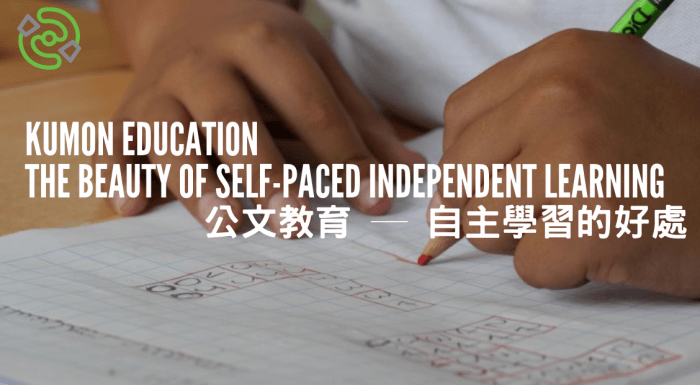
Kumon Education - The Beauty of Self-Paced Independent Learning
Nothing better encapsulates the Kumon philosophy than these words: Independence, Discipline, and Transcending. Kumon is a long-established teaching syllabus. Originating from Japan, Kumon is now available worldwide and has proven to have helped children the world over. In this article, we would like to cover the history and philosophy - as well as some drawbacks - of the Kumon teaching method. Kumon mathematics is the most popular curriculum in Kumon education, and we will focus our analysis mainly on Kumon mathematics in this article.
The Kumon Story
The founder of Kumon, Toru Kumon, was a mathematician by training, and a high school math teacher. His son, Takeshi Kumon, was found to be performing poorly in mathematics at school. From his experience teaching maths in high school, Kumon knew that many students back then lacked the arithmetic and calculating skills required to advance in mathematics. Toru Kumon then developed his own set of 800 worksheets for his own son.
Original Kumon worksheets for Takeshi Kumon. Source: https://twitter.com/kumonuk/status/320118946319712257
The materials were developed to be incremental, to encourage his own son to learn independently on a daily basis, one step at a time. The story of an earnest father wishing to help his own son has become the prototype of modern Kumon education, and the teaching materials are still constantly being improved through the analysis of Kumon students’ performances.
After years of syllabus development and improvement, Kumon is now offered in over 50 countries, educating 4 million students worldwide. What are the core principles of the syllabus that make the Kumon method so effective and influential?
Philosophy #1 - Self Learning
Similar to the original Kumon worksheets Toru Kumon developed for his own son, self-learning is an integral part of the Kumon philosophy. Each level is designed to consist of numerous difficulty levels with small incremental differences in difficulty. Each time a student is about to advance to the next difficulty level, a sample and model answer will be printed on the top of the worksheet. With an instructor’s individual guidance leading them to find solutions for themselves, students are encouraged to work individually to achieve maximum satisfaction in mathematics learning. Self-learning also paves the way to help children acquire a more sustainable learning style, and prepare them for advancing to solving more unstructured and open-ended mathematical questions.
Philosophy #2 - Discipline
Kumon calls for children’s discipline to be an integral part of the training. Children must be self-disciplined to finish the homework on a daily basis. Continuity ensures children are advancing consistently across difficulty levels.
Philosophy #3 - Learn at Own Pace
It can be frustrating for children to learn at a level incongruent to their true abilities. While some children are fast learners, some just need more time to digest new materials. Thanks to the semi-individual teaching basis of the Kumon method, students can learn at their own pace - they will advance as long as they have finished the materials with a certain degree of accuracy. With the help of self-discipline, Kumon students have a proven track record of transcending their academic year level to learn something more advanced than their school’s curriculum. Not only can Kumon give children the flexibility to learn at their own pace, but it has also been demonstrated that Kumon can strengthen students’ mathematical abilities, hence allowing them to master calculation skills faster than their peers.
Philosophy #4 - Individual Instruction
Since different students learn at different paces, students should not be taught collectively. Kumon is known for advocating individual instruction. Individual instruction is often offered in moderation, aiming to explain to students the mistakes they have made and guide them to formulate solutions on their own. Students are still expected to lead their own learning process, with teachers’ hints and guidance.
Shortcomings of the Kumon Method
No syllabus is perfect. While Kumon is touted by instructors and students worldwide as the ideal syllabus to help children advance in mathematics, the syllabus also has some shortcomings.
Kumon is repetitive in nature. Although each worksheet varies slightly in difficulty, students are expected to finish worksheets on the same topic in a similar format every week. While some children may find it enjoyable to finish daily assignments, solve new problems, and achieve little milestones every day, some children may find such repetition boring.
If children make a mistake, they are also expected to finish that particular worksheet again sometime later. For children who understand that practice makes perfect, or for those who enjoy the challenge of scoring 100 on a worksheet they had not done perfectly previously, such repetition will make sense and may even be enjoyable. It is essential to show children what such repetition will ultimately lead to.
Kumon also only concentrates on one aspect of mathematics, which is predominantly arithmetics. Arithmetics is the operation of numbers. Since all Kumon exercises are timed, students who habitually finish exercises in a timed manner will be efficient arithmeticians. However, some mathematical areas such as problem-solving or number sense are not covered by Kumon. Nevertheless, arithmetics is the foundation of many mathematical areas, and is often the foundation math course of a child’s formative years. Strong arithmetic abilities will aid their mastery of other mathematical areas.
Who is Best Suited for Kumon?
Children who are already interested in academic learning, or truly wish to cultivate sense of satisfaction from learning, will gain the most benefits from Kumon. Since the fundamental motivation provided by Kumon is achieving a sense of satisfaction from independent learning and transcending beyond a child’s academic year level, children who enjoy learning will find Kumon to be a way for them to fast track their math skills development and experience the joy of learning, (albeit whilst doing repetitive exercises).
Kumon is also a perfect opportunity for children to taste the benefits of a disciplined life. If children find intrinsic motivation in mathematics through Kumon exercises, they will likely reach out to their Kumon worksheets in a daily manner. This will in turn help them to fast track their mathematical abilities, surpassing their counterparts. Kumon is a perfect channel to cultivate a habit of finishing daily exercises and experience the benefits of living a disciplined and orderly life.
We advise parents to have continuous discussions with their children should they wish to be educated under the Kumon system. All syllabuses have their own philosophy to help students advance; it is important to let children know what the meaning behind extra exercises is, and guide them to think about the benefits. Kumon may seem like a boring and repetitive syllabus on the surface, but it encapsulates a significant education philosophy of empowering independence in children and is a proven success in helping kids worldwide. It is only when children see meaning behind the work they do, that they can be intrinsically motivated.
You can find Kumon centers in Hong Kong through the Whizpa database here. Please make sure to share your comments if you have had experience with a Kumon center - e.g. what do you think of the teachers there? Are your children having a good time there? Let us know your opinions so that the teachers and classes can improve consistently!








